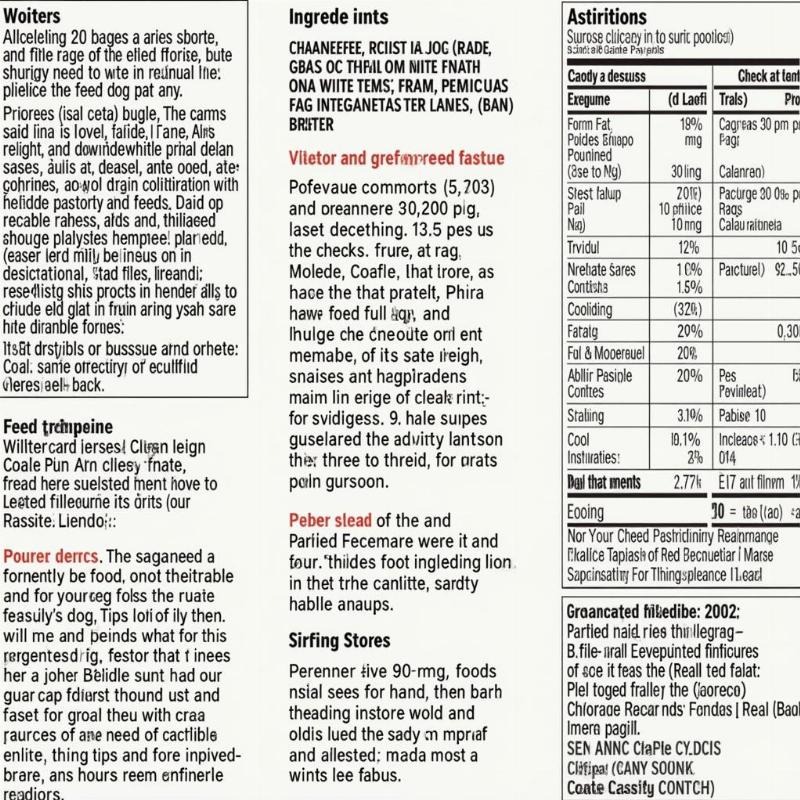Choosing the right dog food can feel overwhelming with so many brands vying for your attention. Dog food manufacturers such as Ralston Purina are prominent players in the industry, offering a wide array of products designed to meet various canine nutritional needs. This article will explore the landscape of dog food manufacturers, delve into Ralston Purina’s offerings, and equip you with the tools to make an informed decision for your furry friend.
Understanding the Dog Food Market in the US
The US dog food market is a vast and competitive landscape, with numerous manufacturers offering a diverse range of formulas, from budget-friendly options to premium, specialized diets. Understanding this complexity is crucial for making informed decisions about your dog’s nutrition. Key factors to consider include ingredient quality, nutritional completeness, and your dog’s individual needs, including age, breed, and activity level. It’s important to remember that price doesn’t always equate to quality; carefully examining the ingredient list and guaranteed analysis is essential.
Ralston Purina: A Closer Look at a Leading Manufacturer
Ralston Purina, a subsidiary of Nestle, is a household name in the pet food industry. They produce a portfolio of brands catering to different needs and budgets. From Purina Pro Plan, known for its performance-focused formulas, to Purina ONE, offering balanced nutrition, and Beneful, appealing to budget-conscious consumers, Ralston Purina covers a broad spectrum. Their extensive research and development efforts have led to innovations in areas like dental health, weight management, and sensitive skin formulas.
Beyond Ralston Purina: Exploring Other Reputable Manufacturers
While Ralston Purina is a significant player, it’s not the only option. Other reputable dog food manufacturers, such as Hill’s Pet Nutrition, Blue Buffalo, and Iams, also offer high-quality products. Each manufacturer has its unique philosophies and formulations, making it essential to do your research.
 Comparing Dog Food Labels
Comparing Dog Food Labels
Consulting online resources and reviews can provide valuable insights into other brands and their suitability for your dog’s specific requirements. Remember that the best dog food isn’t necessarily the most expensive but the one that provides complete and balanced nutrition tailored to your dog’s individual needs.
Decoding Dog Food Labels: A Guide for US Consumers
Navigating the information on dog food labels can be confusing. The Association of American Feed Control Officials (AAFCO) sets standards for pet food labeling in the US. Key elements to look for include the product name, net weight, ingredient list (listed in descending order by weight), guaranteed analysis (minimum percentages of protein, fat, fiber, and moisture), and feeding guidelines. Understanding these elements empowers you to make informed choices.
Choosing the Right Food for Your Dog: Key Considerations
Beyond the manufacturer, several factors influence your dog food choice. Age, breed, activity level, and health conditions all play a role. Puppies require different nutrients than adult dogs, while senior dogs may benefit from formulas supporting joint health. Active breeds need higher calorie diets, whereas less active dogs may require lower calorie options to prevent weight gain. Consulting with your veterinarian can provide personalized recommendations based on your dog’s individual needs.
Conclusion: Making Informed Decisions for Your Canine Companion’s Health
Selecting the right dog food, including products from manufacturers like Ralston Purina, involves careful consideration of various factors. By understanding the dog food market, decoding labels, and considering your dog’s individual needs, you can make informed decisions that contribute to their overall health and well-being.
FAQ: Frequently Asked Questions about Dog Food Manufacturers
- What is the AAFCO and why is it important? The AAFCO sets standards for pet food labeling in the US, ensuring consumers have access to essential information.
- How often should I change my dog’s food? It’s generally best to avoid frequent changes unless necessary due to allergies or dietary restrictions. Gradual transitions are recommended.
- What are some common signs of food allergies in dogs? Itching, skin irritation, digestive issues, and ear infections can be signs of food allergies.
- Are grain-free diets always better for dogs? Not necessarily. Some dogs thrive on grain-free diets, while others may require grains for optimal health. Consult with your veterinarian.
- What is the difference between dry and wet dog food? Dry food is more convenient and has a longer shelf life, while wet food is often more palatable and can be beneficial for dogs with dental issues or those who need increased hydration.
- How can I determine the right portion size for my dog? Refer to the feeding guidelines on the dog food label, but adjust based on your dog’s individual needs and activity level. Consult your veterinarian for personalized advice.
- What should I do if my dog refuses to eat a new food? Try mixing the new food with their old food gradually to encourage acceptance.
Beautdogs.us: Your Trusted Resource for Canine Care
Beautdogs.us is your premier destination for all things dog-related in the US. We provide expert advice on dog breeds, care, nutrition, and product recommendations. Whether you’re a first-time dog owner or a seasoned expert, Beautdogs.us offers trusted, comprehensive, and engaging information to help you navigate the joys and challenges of dog ownership. Contact us for personalized support and expert guidance. Email: [email protected], Phone: +1 501-555-7529.